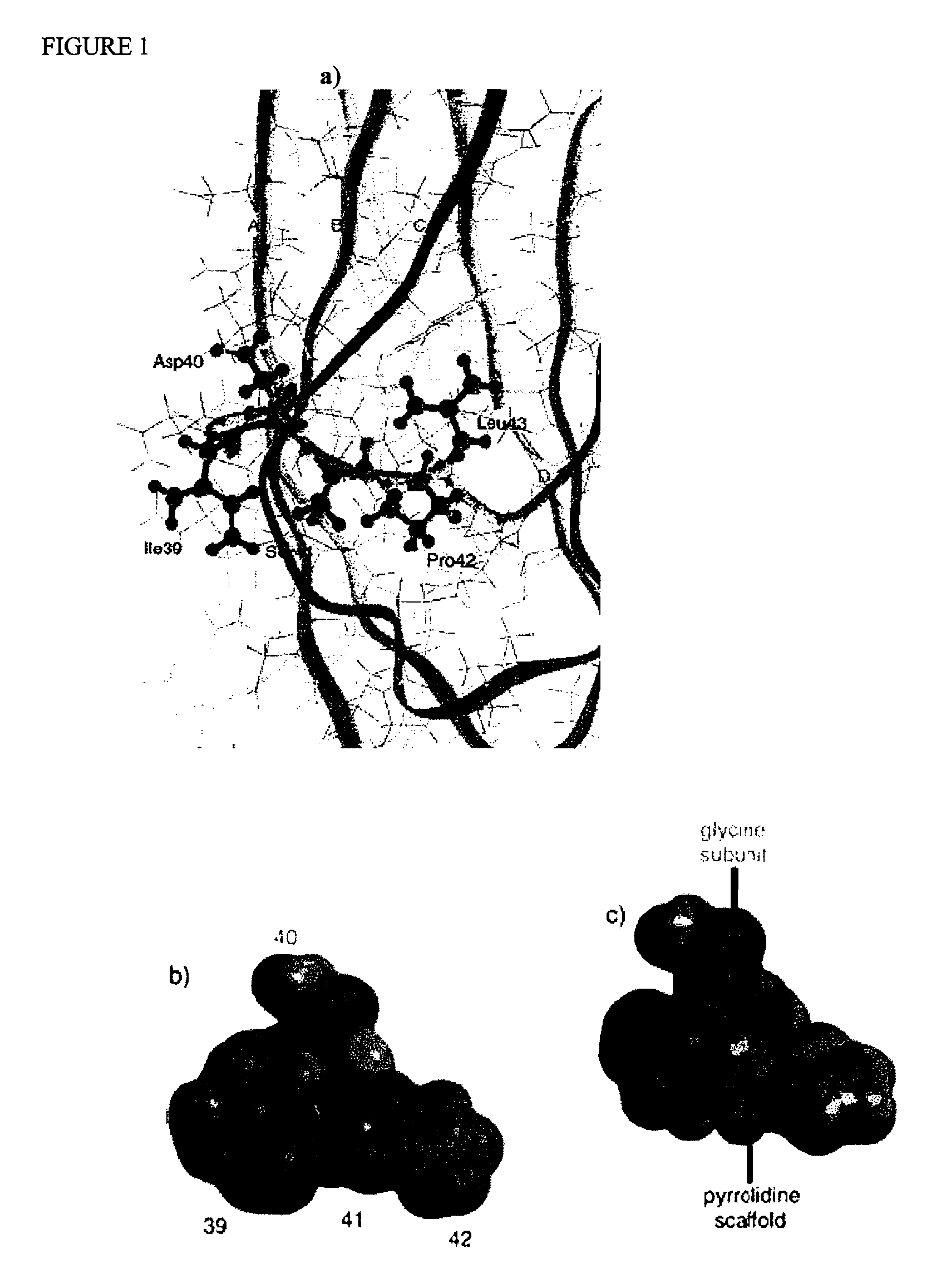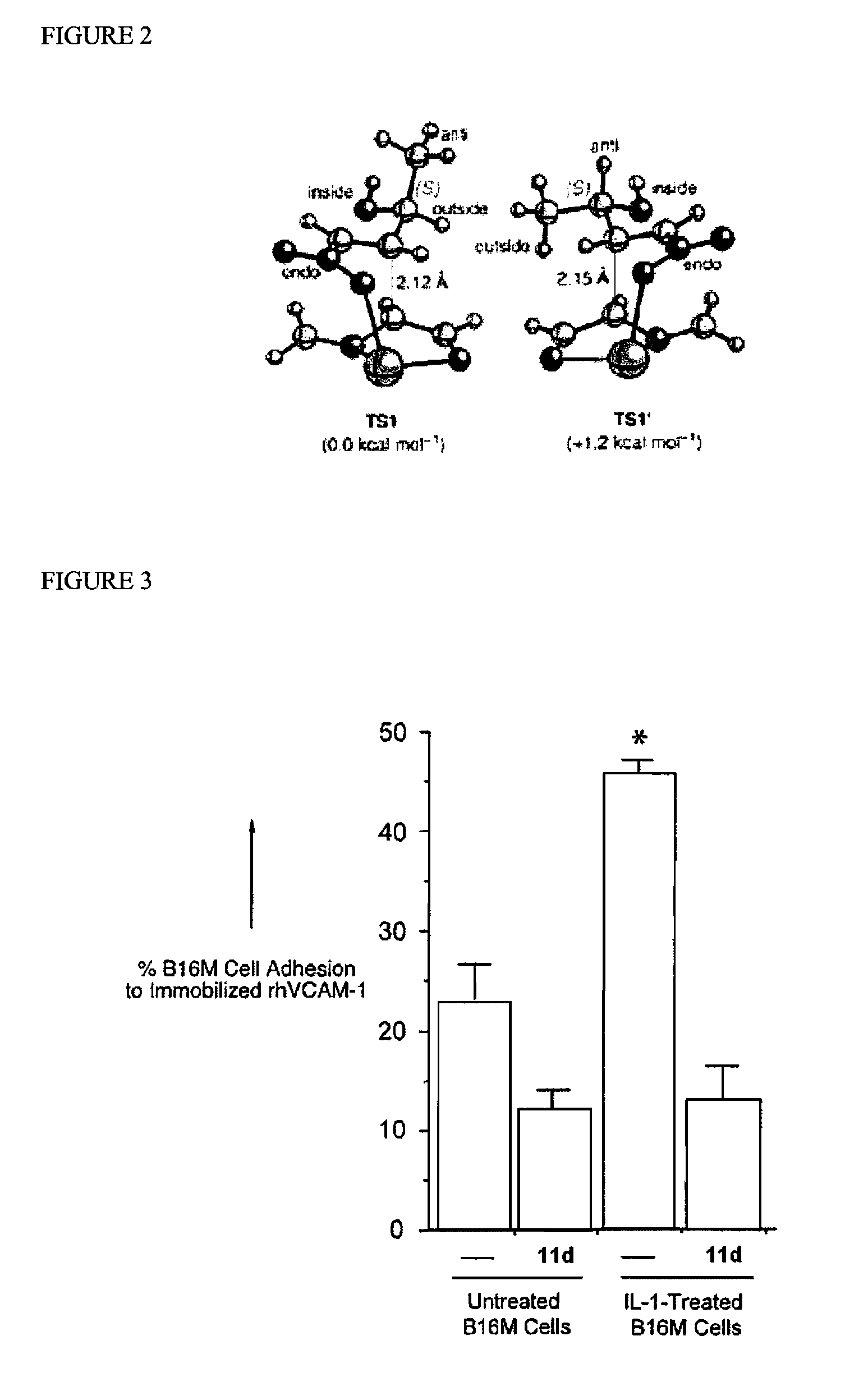Derivatives of nitroproline compounds, processes of manufacture and uses in the treatment of integrin mediated disorders
a technology of nitroproline and derivatives, which is applied in the field of new nitroproline derivatives, can solve the problems of insufficient efficacy of nitroproline in this field, compounds may present bioavailability problems, and have not been tested in complete organism experiments, etc., to achieve easy and efficient chemical synthesis, good pharmacodynamic properties, and high sensitivity
- Summary
- Abstract
- Description
- Claims
- Application Information
AI Technical Summary
Benefits of technology
Problems solved by technology
Method used
Image
Examples
example 2
General Procedure for the Synthesis of α-Benzyloxy Esters 4.
[0080]To a solution of L-amino acid 1 (25.0 mmol) in H2SO4 2N (37.5 ml, aqueous solution), cooled to 0° C., was added a solution of NaNO2 2N (2.57 g, 37.0 mmol) in water (9 ml). The temperature was maintained below 5° C. during the addition, and the mixture was stirred at such a temperature for 24 h. The solution was saturated with (NH4)2SO4, extracted with ether (3×25 ml), dried over Na2SO4 and evaporated under reduced pressure giving 2.72 g (23.0 mmol) of the corresponding α-hydroxy acid as an oil. A solution of this oily material, p-toluenesulfonic acid monohydrate (0.03 g, 0.16 mmol) and dimethoxypropane (2.8 ml, 23.0 mmol) in methanol (1.15 ml) was heated at 45° C. for 24 h. The reaction mixture was evaporated under reduced pressure providing the corresponding □hydroxy methyl ester 2 as an oil. This material was dissolved in anhydrous tetrahydrofuran (40 ml) and anhydrous N,N-dimethylformamide (12 ml), under an inert a...
example 3
General Procedure for the Synthesis of α-Benzyloxy Aldehydes 5
[0087]A solution of lithium aluminum hydride (0.76 g, 20.0 mmol) in anhydrous ether (30 ml), under an inert atmosphere, was cooled to 0° C. The corresponding α-benzyloxy ester 4 (20.0 mmol) in anhydrous ether (40 ml) was added dropwise, and the mixture was stirred at room temperature for 3 h. Then, the reaction mixture was cooled in ice and treated with water (130 ml). The crude was filtrated through Celite, and the filtrate was washed with water (3×80 ml). The remaining organic layer was dried over Na2SO4 and evaporated under reduced pressure, providing the expected alcohol as an oil, which was purified by distillation under reduced pressure using a Kugelrohr. A solution of oxalyl chloride (1.82 ml, 21.0 mmol) in anhydrous methylene chloride (42 ml), under inert atmosphere, was cooled to −70° C. Anhydrous dimethyl sulfoxide (1.96 ml, 28.0 mmol) in anhydrous methylene chloride (42 ml) was added dropwise during 10 min. The...
example 4
General Procedure for the Synthesis of (E)-Nitroalkenes 6
[0094]A mixture of the corresponding aldehyde 5 (16.0 mmol), nitromethane (4.30 ml, 80.0 mmol) and triethylamine (0.32 ml, 2.28 mmol) was stirred at room temperature for 16 h. The excess of nitromethane was removed by evaporation under reduced pressure. The nitroaldol thus obtained as a mixture of diastereomers was dissolved in anhydrous methylene chloride (32 ml) and cooled to −70° C. Methanesulfonyl chloride (1.48 ml, 19.11 mmol) was added dropwise followed by a solution of N,N-diisopropylethylamine (6.85 ml, 39.81 mmol) in dry methylene chloride (8 ml), keeping the reaction mixture below −60° C. The mixture was stirred at −70° C. for 2 h and then allowed to reach room temperature. The solution was washed with water (8 ml), HCl 1 N (4×8 ml, aqueous solution) and brine (8 ml), dried over Na2SO4 and evaporated. The product corresponding nitroalkene was purified by flash column chromatography as a pale yellow oil.[0095][[(S, E)...
PUM
| Property | Measurement | Unit |
|---|---|---|
| temperatures | aaaaa | aaaaa |
| temperatures | aaaaa | aaaaa |
| temperatures | aaaaa | aaaaa |
Abstract
Description
Claims
Application Information
 Login to View More
Login to View More - R&D
- Intellectual Property
- Life Sciences
- Materials
- Tech Scout
- Unparalleled Data Quality
- Higher Quality Content
- 60% Fewer Hallucinations
Browse by: Latest US Patents, China's latest patents, Technical Efficacy Thesaurus, Application Domain, Technology Topic, Popular Technical Reports.
© 2025 PatSnap. All rights reserved.Legal|Privacy policy|Modern Slavery Act Transparency Statement|Sitemap|About US| Contact US: help@patsnap.com



